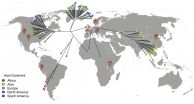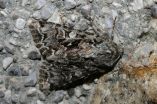INFORMATION:
The online version of the paper can be found at http://www.jbc.org/content/early/2015/07/07/jbc.M115.666156.full.pdf+html
Sequestered prion protein takes the good mood away, suggests new hypothesis on depression
2015-08-13
(Press-News.org) The discovery of antidepressant drugs in the 1950s led to the first biochemical hypothesis of depression, known as the monoamine hypothesis. This hypothesis proposes that an imbalance of certain brain chemicals is the key cause of depression. Research has investigated whether and to what degree the "reward and pleasure" chemical dopamine and, more recently, the "happiness" chemical serotonin, could be the neurotransmitters involved in the malady. However, the monoamine hypothesis does not seem to fully explain the complexity of human depression. Now a new study offers one more important key that may increase our understanding of the pathogenesis behind clinical depression and neurodegenerative disorders.
Proteinaceous infectious particles, also known as prions, are proteins in which the complex molecular three-dimensional folding process has simply gone astray. For reasons not yet understood, the misfolding nature of prions is associated to their ability to sequester their normal counterparts and induce them to misfold as well. The ever-growing crowd of misfolded proteins form the aggregates seen in the brains of patients with neurodegenerative disorders such as Parkinson's and Alzheimer's diseases. Patients with these disorders manifest progressive neurological deterioration and clinical depression, among other symptoms.
Although the misfolded counterparts have historically received all the attention, the spotlight is now on the native protein, namely the prion protein, which is the one that has not undergone misfolding. What role do the native proteins play? An interesting hypothesis is that these particles serve as a hub where some cellular components assemble. For instance, it has already been shown that the prion protein participates in events such as cell proliferation, differentiation and survival. Now a team led by Dr. Rafael Linden from the Institute of Biophysics Carlos Chagas Filho, at the Federal University of Rio de Janeiro, in Brazil, proposes that the prion protein plays a role in depression.
In an article entitled "Prion protein modulates monoaminergic systems and depressive-like behavior in mice" and published in the Journal of Biological Chemistry, the group shows that mice lacking normal prions show a depressive-like behavior similar to depression symptoms found in patients with Alzheimer's and prion diseases, namely Creutzfeldt-Jakob Disease (CJD), variant Creutzfeldt-Jakob Disease (vCJD), Gerstmann-Sträussler-Scheinker syndrome, Fatal Familial Insomnia and kuru. Human prion diseases frequently show clinical symptoms such as depression, anxiety, and hallucinations, and the monoamine hypothesis has been called to explain such deficits.
The research conducted by the group shows that mice with no prion protein have increased levels of the receptors that bind to serotonin. Additionally, the levels of the enzyme that makes dopamine, and dopamine itself, are also higher in mice deprived of the prion protein. Interestingly, the study shows that although these animals have high levels of dopamine, they do not show the normal response that should occur when dopamine binds to its receptor, despite the fact that the levels of the receptor for dopamine are normal in these animals. According to Danielle Beckman, the first author of the paper "it is possible that the lack of interaction between dopamine and its receptor results from a desensitization of the receptor precisely because there is too much dopamine".
Another important observation made by the group, and which supports the hypothesis that prions have a role in depression, is the fact that the prion protein is found in the same places in the cell as the dopamine and serotonin receptors. Additionally, the authors observed that the prion protein might bind to the dopamine receptor.
The group believes that in normal individuals, the prion protein works as a scaffold for multiple molecular interactions. When prion protein molecules are sequestered by their misfolded counterparts, they can no longer work as a scaffold for all these molecular interactions, which impairs the mechanisms evoked by the brain chemicals important for mood.
These findings open the door for future research considering the prion protein as a potential target in the development of treatments for major depression and related disorders.
ELSE PRESS RELEASES FROM THIS DATE:
Dentists tapped for new role: Drug screenings
2015-08-13
August 13, 2015--A visit to the dentist has the potential to be more than a checkup of our teeth as patients are increasingly screened for medical conditions like heart disease and diabetes. A new study by researchers at Columbia University's Mailman School of Public Health focuses on dental screenings for drug misuse, finding 77 percent of dentists ask patients about illicit drug use, and 54 percent of dentists believe that such screenings should be their responsibility. Results of the study are online in the journal Addiction.
"There are a sizeable number of people ...
Birth factors may predict schizophrenia in genetic subtype of schizophrenia
2015-08-13
TORONTO, (Aug. 13, 2015) - Low birth weight and preterm birth appear to increase the risk of schizophrenia among individuals with a genetic condition called the 22q11.2 deletion syndrome, a new study from the Centre for Addiction and Mental Health (CAMH) shows.
The research, published in Genetics in Medicine, is "...part of ongoing efforts among schizophrenia researchers to predict and prevent illness at the earliest stages possible," says senior author Dr. Anne Bassett, Clinician-Scientist in CAMH's Campbell Family Mental Health Research Institute and Canada Research ...
Biochemist studies oilseed plants for biofuel, industrial development
2015-08-13
MANHATTAN, Kansas -- A Kansas State University biochemistry professor has reached a milestone in building a better biofuel: producing high levels of lipids with modified properties in oil seeds.
Timothy Durrett, assistant professor of biochemistry and molecular biophysics, and collaborators at Michigan State University and the University of Nebraska, Lincoln have modified Camelina sativa -- a nonfood oilseed crop -- and produced the highest levels of modified seed lipids to date. By modifying the oilseed biochemistry in camelina, the researchers have achieved very high ...
High participation in small church groups has its downside, research shows
2015-08-13
CLEMSON, S.C. -- Parishioners who participate in small groups within a religious congregation are generally more likely to be civically engaged than their fellow worshipers unless a church has high overall small-group participation, according to research recently released by Clemson and Louisiana State universities.
The study, "Small groups, contexts, and civic engagement: A multilevel analysis of United States Congregational Life Survey data," published in the July issue of the journal Social Science Research, reveals that the positive effect small-group participation ...
Toxic blue-green algae pose increasing threat to nation's drinking, recreational water
2015-08-13
CORVALLIS, Ore. - A report concludes that blooms of toxic cyanobacteria, or blue-green algae, are a poorly monitored and underappreciated risk to recreational and drinking water quality in the United States, and may increasingly pose a global health threat.
Several factors are contributing to the concern. Temperatures and carbon dioxide levels have risen, many rivers have been dammed worldwide, and wastewater nutrients or agricultural fertilizers in various situations can cause problems in rivers, lakes and reservoirs.
No testing for cyanobacteria is mandated by state ...
Statistical advances help unlock mysteries of the human microbiome
2015-08-13
SEATTLE, WA, AUGUST 13, 2015 - Advances in the field of statistics are helping to unlock the mysteries of the human microbiome--the vast collection of microorganisms living in and on the bodies of humans, said Katherine Pollard, a statistician and biome expert, during a session today at the 2015 Joint Statistical Meetings (JSM 2015) in Seattle.
Pollard, senior investigator at the Gladstone Institutes and professor of epidemiology and biostatistics at the University of California, San Francisco, delivered a presentation titled "Estimating Taxonomic and Functional Diversity ...
Remote sensing, satellite imagery, surveys use to estimate population of Mogadishu
2015-08-13
SEATTLE, WA, AUGUST 13, 2015 - The results of the first population survey of Mogadishu, Somalia, conducted in a quarter century were presented today at a session of the 2015 Joint Statistical Meetings (JSM 2015) in Seattle.
Jesse Driscoll, assistant professor of political science at the University of California, San Diego, presented the results in an invited presentation titled "Representative Surveys in Insecure Environments: A Case Study of Mogadishu, Somalia."
The representative survey, conducted in March 2012, combined the use of smartphone technology and remote-sensing ...
How do continents break up?
2015-08-13
12.08.2015: When the western part of the super-continent Gondwana broke up around 130 Million years ago, today's Africa and South-America started to separate and the South Atlantic was born. It is commonly assumed that enormous masses of magma ascended from the deep mantle up to higher levels, and that this hot mantle plume (the Tristan mantle plume) weakened the continental lithosphere, eventually causing the break-up of the continental plate of Gondwana.
A group of German scientists are now questioning this theory. On the basis of seismic measurements published in ...
Diversity provides stability among the animals in the wild
2015-08-13
This news release is available in German.
Kalmar/Halle(Saale). Why some species of plants and animals vary more in number than others is a central issue in ecology. Now researchers at Linnaeus University in Sweden and from the Helmholtz Centre for Environmental Research (UFZ) have found an important finding to answer this question: Individual differences have a positive and stabilizing effect on the number of moths. Species with varying colour drawing are generally more numerous and fluctuate less in number from year to year. The results were recently published ...
Smoking ban linked to drop in stillbirths and newborn deaths
2015-08-13
Stillbirths have dropped by almost eight per cent in England since the smoking ban was introduced, research shows.
The number of babies dying shortly after birth has also dropped by almost eight per cent, the study estimates.
The findings add to growing evidence that anti-smoking laws have had significant benefits for infant and child health.
Researchers led by the University of Edinburgh looked at information on more than ten million births in England between 1995 and 2011.
Their findings suggest that almost 1500 stillbirths and newborn deaths were averted in ...


